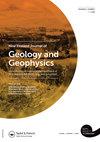Spinizonocolpites prominatus(McIntyre)Stover&Evans:Nypa花粉化石、分类学、形态学、全球分布和古环境意义
IF 1.9
4区 地球科学
Q1 GEOLOGY
New Zealand Journal of Geology and Geophysics
Pub Date : 2022-05-25
DOI:10.1080/00288306.2022.2078376
引用次数: 8
摘要
摘要在新西兰坎特伯雷早始新世沉积物中描述了一种monosulcite珥atus化石。它类似于红树棕榈的花粉。随后,提出了Spinizonocolpites新属和一个模式种S. echinatus,我们认为它是S. pronatus的初级同义种。然而,S. pronatus并不总是被认为是模式物种,许多作者认为S. echinatus是“原始”类型。大约有37种spinizonocolites被描述,尽管其中一些无疑是同义词。许多与Nypa有亲缘关系,最早出现在晚白垩纪,特别是在南美洲北部、非洲、印度和婆罗洲。在古新世,印度次大陆似乎是全球nypa类物种多样性的中心,具有高度多样性的spinizonocolites物种。在始新世期间,Nypa在全球范围内分布最广,但始新世中期全球变冷的开始导致最终范围缩小到北澳大利亚、印度尼西亚群岛、菲律宾群岛和今天的中国。沉积物样品中Nypa花粉的存在表明红树林环境是泥泞的,缓慢移动的潮汐河口或受淡水和咸淡水影响的河流。本文章由计算机程序翻译,如有差异,请以英文原文为准。
Spinizonocolpites prominatus (McIntyre) Stover & Evans: fossil Nypa pollen, taxonomy, morphology, global distribution, and paleoenvironmental significance
ABSTRACT The fossil species Monosulcites prominatus was described from Early Eocene sediments in Canterbury, New Zealand. It resembles the pollen of the mangrove palm Nypa fruticans. Subsequently, the new genus Spinizonocolpites was proposed with a type species, S. echinatus, which we consider to be a junior synonym of S. prominatus. However, S. prominatus has not always been recognised as the type species, with many authors deferring to the ‘original’ type, S. echinatus. Some 37 species of Spinizonocolpites have been described, though several are undoubtedly synonyms. Many have an affinity to Nypa and the earliest appeared in the Late Cretaceous, especially in northern South America, Africa, India and Borneo. The Indian subcontinent appears to have been the global centre of diversity of Nypa-like species during the Paleocene with a high diversity of Spinizonocolpites species. Nypa was most widespread globally during the Eocene, but the onset of global cooling in the late Middle Eocene resulted in the ultimate range contraction to Northern Australia, the Indonesian Archipelago, the Philippine Islands and China present day. The presence of Nypa pollen in sediment samples indicates a mangrove environment of muddy, slow moving tidal estuaries or rivers influenced by fresh and brackish waters.
求助全文
通过发布文献求助,成功后即可免费获取论文全文。
去求助
来源期刊
CiteScore
5.10
自引率
27.30%
发文量
34
审稿时长
>12 weeks
期刊介绍:
Aims: New Zealand is well respected for its growing research activity in the geosciences, particularly in circum-Pacific earth science. The New Zealand Journal of Geology and Geophysics plays an important role in disseminating field-based, experimental, and theoretical research to geoscientists with interests both within and beyond the circum-Pacific. Scope of submissions: The New Zealand Journal of Geology and Geophysics publishes original research papers, review papers, short communications and letters. We welcome submissions on all aspects of the earth sciences relevant to New Zealand, the Pacific Rim, and Antarctica. The subject matter includes geology, geophysics, physical geography and pedology.

 求助内容:
求助内容: 应助结果提醒方式:
应助结果提醒方式:


